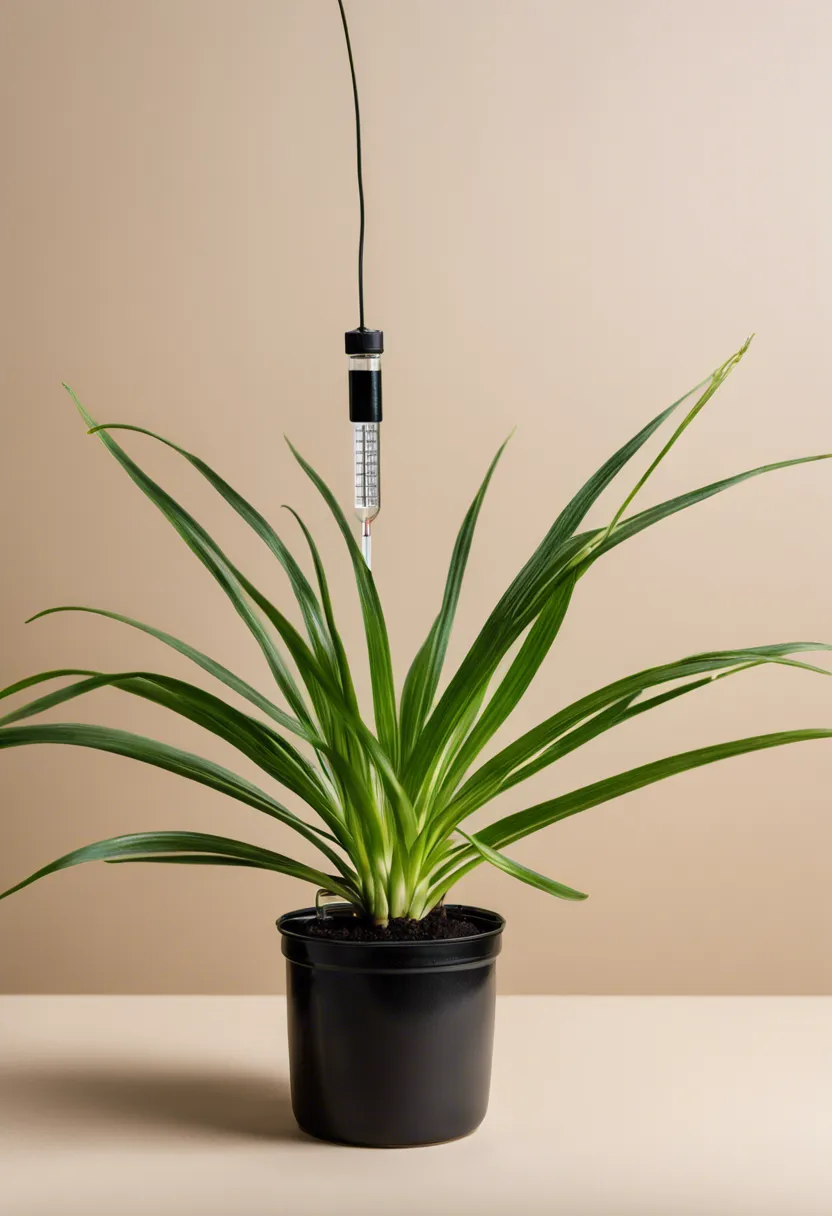Oh no! You’ve noticed your Spider Plant Leaves Turning Black and you’re wondering why. Don’t panic, we’re here to help!
Maybe you’ve been watering it just right, or perhaps it’s in that perfect sunny spot. But despite your efforts, those pesky black spots keep appearing.
Keep reading about ‘Why are My Spider Plant Leaves Turning Black?’ We’ll dive into the possible causes and solutions for this common problem.
Key Takeaways
- Spider plant leaves turning black is often due to overwatering, causing root rot.
- Cold temperatures can also cause blackening. Keep your plant in a room above 50°F.
- Pests like spider mites may be the culprits. Check under the leaves!
- Fungal diseases can turn leaves black. If you spot fuzzy white stuff, it’s probably fungus.
- Lastly, poor quality water with high fluoride or chlorine levels can harm your plant. Try using filtered water instead!

Understanding Spider Plants
Spider plants, known scientifically as Chlorophytum comosum, are the unsung heroes of the indoor gardening world. With their lush, arching leaves and easy-going nature, they’ve become a staple in homes around the globe. Let’s dive into what makes these green beauties tick and how to keep them happy and healthy.
What are Spider Plants?
Chlorophytum comosum, or as we like to call them, spider plants, are not just any old houseplant. They hail from tropical and southern Africa but have made themselves right at home in our living rooms and offices. Why? Because they’re practically superheroes of the plant world. Not only do they rock at purifying the air—making your home feel fresh—they’re also ridiculously easy to care for. This makes them a top pick for both seasoned indoor gardeners and those of us who might not have the greenest thumbs.
Spider plants are famous for their resilience and adaptability, thriving in a variety of conditions with minimal fuss. They don’t demand much: some indirect sunlight here, a bit of water there, and voilà! You’ve got yourself a happy little plant that keeps on giving with its charming baby spiderettes.
Characteristics of Healthy Spider Plants
So, what does it look like when a spider plant is living its best life? First off, you’ll notice its vibrant foliage. Healthy spider plants boast rich green leaves with a characteristic white stripe running down the center—like nature’s own racing stripe. These leaves should feel firm to the touch and stand out proudly from the pot.
Growth rate is another telltale sign; these plants can be quite prolific under the right conditions, producing not only new leaves but also adorable little offshoots known as “pups.” And let’s not forget about roots—a healthy spider plant has strong, white roots that are eager to explore their surroundings.
Common Problems with Spider Plants
But alas, even superheroes have their kryptonite. For spider plants, common foes include pesky pests like spider mites or scale insects and dreaded diseases such as root rot. Brown leaf tips can signal that all is not well in paradise—often due to over-fertilization or fluoride in tap water.
Pest infestation symptoms might include tiny webs or sticky residue on leaves—a clear sign it’s time for action. Root rot presents itself through mushy, discolored roots—a consequence of overwatering or poor drainage. Fear not; while these issues sound dire, they’re often manageable with some timely care and attention.
Causes of Black Leaves in Spider Plants
Discovering Spider Plant Leaves Turning Black can be a real head-scratcher. But don’t fret! The culprits are usually overwatering and root rot, cold damage, or pesky pests and diseases. Let’s dive into these murky waters.
Overwatering and Root Rot
Ever given your spider plant so much love it started to drown? That’s overwatering for you. It’s like throwing a pool party in your plant’s pot without an exit strategy for the water. Signs of overwatering include soggy soil, wilting, and yes, spider plant leaves turning black. The trick is to let the soil dry out a bit between waterings. Think of it as giving your plant a breather.
Now, if you’ve been overly generous with water, you might have invited root rot to the party. This sneaky issue turns roots mushy and black as they give up on life. It’s the silent killer behind many spider plant care woes. To avoid this drama, ensure your pot has drainage holes fit for a king and use soil that doesn’t hold onto water like it’s treasure. Managing soil moisture is key to preventing root rot and keeping those leaves green instead of black.
Cold Damage
Imagine wearing shorts in a snowstorm; that’s how your spider plant feels when hit by cold damage. Those black leaves are its way of saying, “I’m freezing!” Spider plants enjoy cozy temperatures – not too hot, not too cold. If Jack Frost has been nipping at your plant’s nose (or leaves), you’ll see darkened patches that scream cold damage in plants.
To shield your green buddy from shivering its leaves off, keep it away from drafty windows in winter and ensure the room stays at a comfortable temperature. Remember, protecting plants from cold isn’t just about warmth; it’s about avoiding sudden temperature drops which can be quite shocking for them. If your plant has already suffered from frostbite, trim off the damaged parts gently to help it recover gracefully.
Pests and Diseases
Just when you thought things couldn’t get darker than spider plant leaves turning black, enter stage left: pests and diseases. These uninvited guests range from spider mites sucking the life out of leaves to fungal infections throwing a spotty party.
First up are pests like spider mites which are tiny critters with an appetite for destruction. They leave behind telltale signs such as fine webs and speckled leaves. For an eco-friendly eviction notice, introduce them to their nemesis – neem oil or insecticidal soap.
Then there are diseases like fungal infections that turn leaf tips black as they advance uninvited across your plant. Ensuring good air circulation around your plants can prevent these parties before they start while removing affected areas stops them in their tracks.
By staying vigilant against these threats with regular check-ups and adopting preventive measures such as proper watering practices and maintaining ideal environmental conditions, you can keep those spider plant leaves lushly green instead of ominously black.



Step-by-Step: How to Treat Black Leaves in Spider Plants


So, your spider plant’s leaves have turned into a gothic garden feature, and you’re not here for it. Fear not! Treating black leaves on your spider plant isn’t as daunting as it might seem. Let’s break down the rescue mission into simple, actionable steps. By following these guidelines, you’ll give your plant the best shot at bouncing back to its vibrant self.
-
Identify the cause of the black leaves. Before you play plant doctor, make sure you know what you’re treating. Is it overwatering? A fungal infection? Too much direct sunlight? Understanding the root of the problem is crucial.
-
Trim away the affected leaves. Use a clean, sharp pair of scissors or pruning shears to cut off the blackened leaves. This prevents any potential disease from spreading and helps your plant focus its energy on new growth. Remember, cleanliness is next to godliness here; ensure your tools are disinfected before and after use.
-
Adjust watering habits if necessary. If overwatering is the culprit, let the soil dry out more between waterings. Stick your finger about an inch deep into the soil; if it feels dry, it’s time to water again.
-
Improve drainage by ensuring your pot has adequate drainage holes and consider mixing perlite or sand into your potting soil to increase aeration and water flow.
-
Relocate your plant if it’s been getting too much direct sunlight which can scorch its leaves turning them black over time. Find a spot that receives bright but indirect light.
-
Fungicide application might be necessary if a fungal infection is identified as the cause of blackening leaves. Opt for an organic fungicide and follow the application instructions carefully to avoid harming your plant further.
-
Increase humidity around your spider plant by misting it regularly or placing a humidifier nearby especially if you suspect low humidity levels are contributing to its distress.
-
Monitor closely for signs of recovery or further decline in health after implementing these changes. Patience is key; plants take time to heal and adjust to new conditions.
By tackling each step with care and attention, you’ll not only address the immediate issue of black leaves but also create a healthier environment for your spider plant’s long-term growth and happiness.
Preventive Measures for Healthy Spider Plant Growth
So, your spider plant is throwing a tantrum with those black leaves, huh? Fear not! It’s like dealing with a moody teenager; you just need to know the right buttons to push. Here’s how you can keep your green buddy happy and thriving, avoiding those dreaded black leaves.
-
Water Wisely: Think of your spider plant like a camel. It doesn’t need a flood; just consistent sips. Let the soil dry out a bit between waterings to avoid overwatering, which is basically like giving your plant soggy boots to wear. Yuck!
-
Light it Right: These plants are like that friend who loves the sun but burns easily. Bright, indirect light is their jam. Too much direct sunlight is like forcing them into a tanning bed—hello, sunburn!
-
Keep it Cool: Spider plants are chill at heart. They enjoy temperatures between 55°F and 80°F (13°C – 27°C). Anything hotter and they might start sweating black ink.
-
Feed but Don’t Fatten: Imagine feeding candy to a baby—too much and it goes bonkers; too little and it’s cranky. Fertilize your spider plant sparingly, about once a month during spring and summer with half-strength liquid fertilizer. It’s like their version of a balanced diet.
-
Humidity is Happiness: These plants love to stay hydrated but through the air, not their roots. Think tropical breeze, not swamp feet. A room humidifier or misting them occasionally will make them feel right at home.
-
Repotting Rituals: Like us outgrowing our clothes, spider plants outgrow their pots. Give them a new spacious home every couple of years with fresh soil to stretch their roots.
-
Pest Patrol: Keep an eye out for uninvited guests like spider mites or aphids trying to crash the party on your plant’s leaves. A gentle shower or insecticidal soap can send these party poopers packing.
Remember, keeping your spider plant happy isn’t rocket science—it’s more like being a good plant parent who knows when to water, feed, and tuck them into just the right spot in the house!


To Wrap Up
So, there you have it! We’ve demystified the mystery of Spider Plant Leaves Turning Black. Remember, the blackening could be due to over-watering, cold drafts or fungal infections.
Don’t freak out at the first sign of black leaves. Adjust your watering routine, check for drafts and consider a fungicide if necessary.
Finally, keep an eye on your plant’s environment. Happy spider plant parenting!


